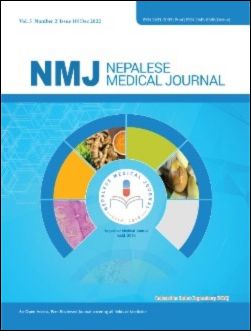Gestational Trophoblastic Diseases at a Tertiary care Hospital in Nepal: A Five Years Retrospective Study
DOI:
https://doi.org/10.3126/nmj.v5i2.46966Keywords:
Beta-hCG, Gestational trophoblastic disease, Histopathology, Hydatidiform moleAbstract
Introduction: Gestational trophoblastic diseases, because of their diverse presentation and the malignant lesions being associated with recurrence, metastasis, and mortality, early diagnosis is important with the help of ultrasonogram preoperatively, serial Beta human chorionic gonadotropin, and histopathological examination for prompt treatment and timely management of the patients. The study aimed to identify the overall prevalence and relative frequencies of Gestational trophoblastic diseases and to assess the association of different gestational trophoblastic diseases with maternal age, parity, and gestational age.
Materials and Methods: This is a retrospective cross-sectional study conducted for five years from January 2016 to December 2020 in the Department of Pathology, and Department of gynecology and obstetrics of Dhulikhel Hospital, Kavre Nepal. This study included a spectrum of gestational trophoblastic diseases. All the details were obtained from the patient’s record file and register book.
Results: Out of 65 cases, the most common was Hydatidiform mole with 59 (90.78%) cases. Bleeding per vagina was the most common clinical presentation. The most commonly affected age group was 21-25 years. Most of the gestational trophoblastic diseases were detected in the first trimester and primigravida.
Conclusions: Any pregnant woman presenting with abnormal uterine bleeding should be evaluated for the presence of underlying Gestational trophoblastic disease. Beta-hCG is a sensitive marker, however, histopathology remains a gold standard modality for the detection of gestational trophoblastic diseases. The judicious use of ultrasonograms and appropriate clinicopathological approach helps the clinician to decide the treatment modalities, especially between evacuation and hysterectomy.
Downloads
Downloads
Published
How to Cite
Issue
Section
License
Copyright (c) 2022 Nikita Gautam, Ramesh Makaju, Dipika Basnet, Binita Lama, Prem Bahadur Maharjan, Sunila Shakya

This work is licensed under a Creative Commons Attribution 4.0 International License.
This license enables reusers to distribute, remix, adapt, and build upon the material in any medium or format, so long as attribution is given to the creator. The license allows for commercial use.
Copyright on any article published by Nepalese Medical Journal is retained by the author(s).
Authors grant Nepalese Medical Journal a license to publish the article and identify itself as the original publisher.
Authors also grant any third party the right to use the article freely as long as its integrity is maintained and its original authors, citation details and publisher are identified.




